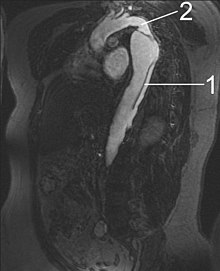Arterial dissections
This article needs additional citations for verification. (December 2013) |
| Arterial dissections | |
|---|---|
 | |
| Aortic dissection | |
| Specialty | Vascular surgery |
An arterial dissection is a tear within the wall of an artery, which allows blood to separate the wall layers. There are several types. Usually, a tear is in an arterial wall, but a vein wall tear has been documented.[1]
By separating a portion of the wall of the artery (a layer of the tunica media or in some cases tunica intima), a tear creates two lumens or passages within the vessel, the original or true lumen, and the false lumen created by the new space within the wall of the artery. It is not yet clear if the tear in the innermost layer, the tunica intima, is secondary to the tear in the tunica media. Dissections originating in the tunica media are caused by disruption of the vasa vasorum. It is thought that dysfunction in the vasa vasorum is an underlying cause of dissections.[2]
Description
Arterial dissections become life-threatening when growth of the false lumen prevents

1 Aorta descendens with dissection
2 Aorta isthmus
Vessels and organs that are perfused from a false lumen may be well-perfused to varying degrees, from normal perfusion to no perfusion. In some cases, little to no end-organ damage or failure may be seen. Similarly, vessels and organs perfused from the true lumen but distal to the dissection may be perfused to varying degrees. In the above example, if the aortic dissection extended from proximal to the left subclavian artery takeoff to the mid descending
Types
Examples include:
- Aortic dissection (aorta)
- coronary artery) also referred to as spontaneous coronary artery dissectionor SCAD
- Pulmonary artery dissection (pulmonary artery) an extremely rare condition as a complication of pulmonary hypertension[3]
- Carotid artery dissection (carotid artery)
- Vertebral artery dissection (vertebral artery)
Carotid and vertebral artery dissection are grouped together as "Cervical artery dissection" (CeAD).
Common features
As a disease family, arterial dissections share common features, including shared genetic risk variants, and commonly perturbed molecular pathways.
